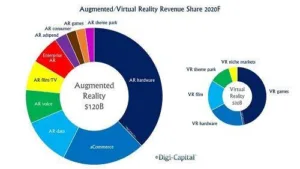Whenever a new technology comes along, the ultimate question is ‘How much revenue will it create?’. In the case of VR and AR most researchers see this as a high potential technology that is still very much in its infancy. At the recent Game Developers Conference in San Francisco, the name of the game was not if AR/VR will be big business, but when.
According to an article in EE Times, proponents were very positive about the outlook on AR / VR during a panel discussion. Digi-Capital, an investment firm focusing on the AR and VR market is especially positive on the potential outcome. They foresee AR creating a $120billion market by 2020, while VR will be around $30billion. They also show a breakdown by various applications. In the AR world they believe that the hardware segment will create the largest revenue stream, while for VR games will create the most money.
They see still major hurdles in the technology such as field of view, power consumption, battery life, latency, etc. As those issues are being resolved, AR and VR will be taking off, with VR leading the early charge, while AR will be surpassing VR in the 2018 /2019 time frame. They expect the smart glasses becoming so perfect that they may even make smartphones obsolete.
This will be partially supported by massive investments into this technology last year as well as this year. With the continued investment, the viewer experience will become better and convince consumers to go for this technology.
Analyst Comment
While we have been surprised by the last two mobile device introductions (smartphones and tablets), it is somewhat hard to believe that in four years from now AR and VR would be accounting for a $150 billion a year business.
Now if I would run a VC company focusing on AR and VR I would like to believe that as well, it is just not very likely to become reality. First of all, VCs tend to misjudge technology development time frames. In the case of AR especially, we need to develop technologies that allow for thin and curved optical combiners. Such technologies exist, but are far away from cost effective manufacturing methods and respective production capacity. Technological development has its way of throwing a wrench in any otherwise brilliant business plan. We will just see how it goes from here. – NH

